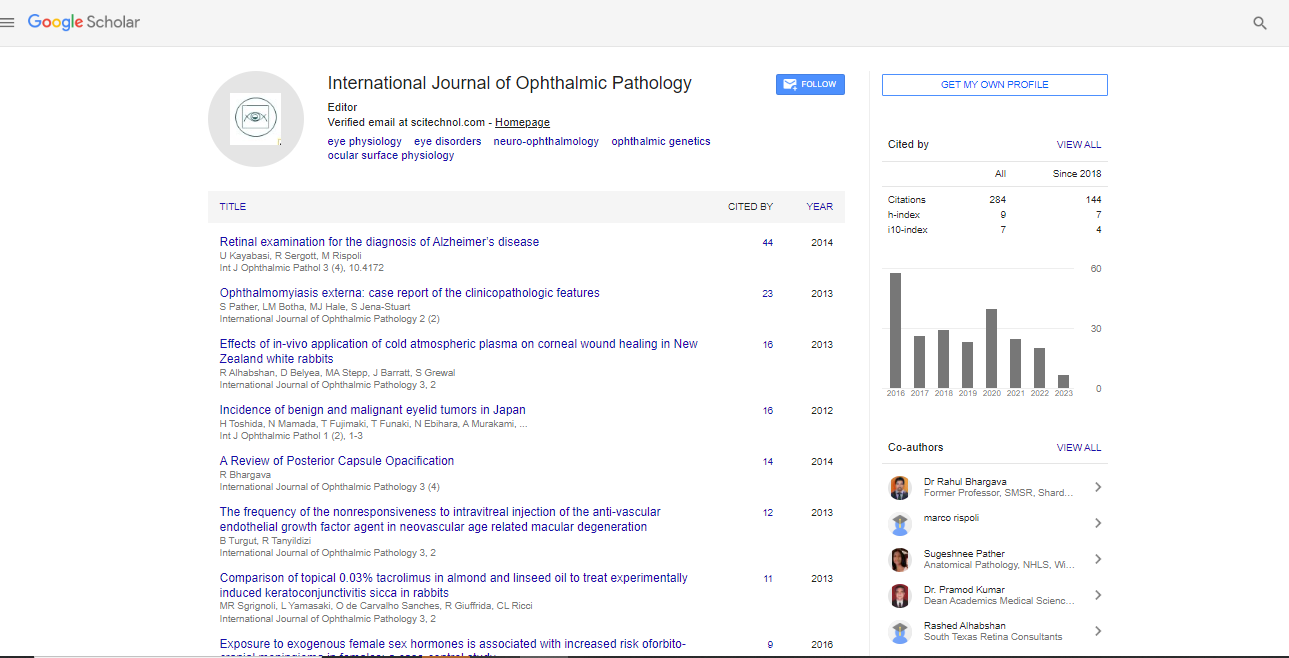Commentary, Vol: 14 Issue: 1
Enhancing Quality of Life through Vision Rehabilitation
Gianni Wentz*
Department of Ophthalmology, Queen's University, Ontario, Canada
*Corresponding Author: Gianni Wentz Department of Ophthalmology, Queen's University, Ontario, Canada, E-mail: gianwent@queensu.ca
Received date: 07 April, 2024, Manuscript No. IOPJ-24-131709; Editor assigned date: 09 April, 2024, PreQC No. IOPJ-24-131709 (PQ); Reviewed date: 24 April, 2024, QC No. IOPJ-24-131709; Revised date: 07 February, 2025, Manuscript No. IOPJ-24-131709 (R); Published date: 14 February, 2025, DOI: 10.4172/2324-8599.1000054
Citation: Wentz G (2025) Enhancing Quality of Life through Vision Rehabilitation Int J Ophthalmic Pathol 14:1.
Description
Vision impairment can significantly impact an individual's quality of life, affecting independence, mobility and overall well-being. However, with advancements in vision rehabilitation, individuals with visual challenges have access to comprehensive support and resources aimed at maximizing their independence and enhancing the overall quality of life. Vision rehabilitation encompasses a range of services and interventions designed to help individuals with vision loss adapt to their condition and achieve optimal independence. It includes all the functional aspects of vision loss but also the psychosocial and emotional implications, aiming to empower individuals to lead fulfilling lives despite visual challenges. Vision rehabilitation begins with a comprehensive assessment of an individual's functional vision. This evaluation helps identify remaining visual abilities, areas of difficulty and specific rehabilitation needs. Orientation and mobility training teaches individuals techniques to go through the environment safely and confidently. This includes learning to use mobility aids such as canes or guide dogs, as well as mastering orientation skills for independent travel.
Activities of Daily Living (ADL) training focuses on developing strategies to perform daily tasks independently despite vision loss. This may include techniques for cooking, grooming, managing medications and organizing the home environment for safety and efficiency. Assistive technology plays a vital role in vision rehabilitation, providing tools and devices to facilitate independence. This includes screen readers, magnification software, speech-to-text applications and tactile aids that enable individuals to access information and communicate effectively. Low vision rehabilitation addresses the unique needs of individuals with significant visual impairment who have some remaining vision. This may involve prescribing low vision aids such as magnifiers, telescopes or electronic devices to optimize remaining vision for specific tasks. Managing vision loss can be emotionally challenging and vision rehabilitation programs often include psychological support and counseling services. These services help individuals adjust to their condition build resilience and develop strategies for dealing to understand the emotional aspects of vision loss.
Vision rehabilitation empowers individuals to regain independence and mobility, allowing them to explore the environment with confidence. By mastering orientation and mobility skills and utilizing assistive technology, individuals can engage in activities such as traveling independently, shopping and participating in social events. Vision loss can sometimes lead to social isolation, but vision rehabilitation aims to counteract this by promoting social participation. Through training in communication skills, adaptive techniques and confidence-building exercises, individuals can maintain social connections and actively participate in community life. Vision rehabilitation plays a vital role in facilitating employment and educational opportunities for individuals with vision loss. By equipping them with adaptive skills, assistive technology and vocational training, vision rehabilitation enables individuals to pursue career goals and educational aspirations.
Conclusion
Managing vision loss can be extremely difficult for emotional wellbeing, but vision rehabilitation provides essential support to deal with psychological and emotional needs. Counseling and support groups provide a safe space for individuals to express their feelings, share experiences and receive encouragement from peers and professionals. Vision rehabilitation is a multidimensional approach aimed at enhancing the quality of life for individuals with vision loss. Through resolving functional, psycho-social and emotional needs, vision rehabilitation empowers individuals to lead fulfilling and independent lives. Through orientation and mobility training, assistive technology, low vision aids and psychological support, individuals with vision loss can overcome challenges, achieve their goals and actively participate in society. As advancements in vision rehabilitation continue to evolve, the future has potential for further improving outcomes and maximizing independence for individuals with visual impairments.
 Spanish
Spanish  Chinese
Chinese  Russian
Russian  German
German  French
French  Japanese
Japanese  Portuguese
Portuguese  Hindi
Hindi 